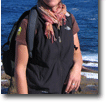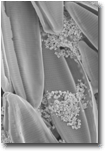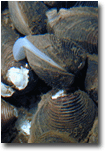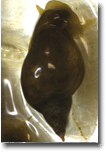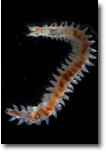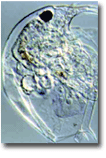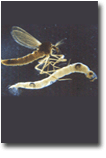| Marie-Noële
Croteau
Research biologist
B.Sc. University of Québec in Rimouski,
Biology
M.Sc. INRS-Eau (University of Québec), Water Sciences
and Environment
Ph.D. INRS-Eau (University of Québec), Water Sciences
and Environment
mcroteau@usgs.gov
Research Interests
My research aims at linking contaminant bioavailability to
toxicity, especially for aquatic organisms exposed to metals
and metallo-nanomaterials through solution and diet. I am
especially interested in improving our understanding of the
physiological and geochemical processes that influence metal
bioaccumulation. Biodynamic modelling and enriched stable
isotope tracers are the centerpiece of my work. For instance,
I develop and refine biogeochemical methodologies to quantify
responses of organisms to metal-stresses. Specifically, I
conduct experiments where I employ biodynamic principles and
isotope tracers to investigate the relationships between contaminant
exposure and bioaccumulation, as well as between contaminant
fluxes and toxicity. The parameterization of species-specific
and metal-specific processes (e.g., feeding rates, assimilation
efficiencies, loss and detoxification rates) allows predicting
the risks and effects of metals and metallo-nanomaterials
exposure.
Recent publications
Misra, SK., Dybowska, A., Berhanu,
D., Croteau, M.-N., Luoma, SN., Boccaccini, AR., Valsami-Jones,
E. 2012. Isotopically modified nanoparticles for enhanced
detection in bioaccumulation studies. Environ.
Sci. Technol. 46: 1216-1222
Croteau, M.-N., Misra, S.K., Luoma,
S.N., & Valsami-Jones, E. 2011. Silver bioaccumulation
dynamics in a freshwater invertebrate after aqueous and dietary
exposures to nanosized and ionic Ag. Environ.
Sci. Technol. 45: 6600-6607 Supporting
Information
Cain, D., Croteau MN & Luoma, SN.
2011. Bioaccumulation dynamics and exposure routes of Cd and
Cu among species of aquatic mayflies. Environ.
Toxicol. Chem. 30: 2532-2541
Dybowska AD., Croteau MN, Misra
SK, Berhanu D, Luoma SN, Christian P., O'Brien P & Valsami-Jones
E. 2011. Synthesis of isotopically modified ZnO nanoparticles
and their potential as nanotoxicity tracers. Environ.
Pollution. 159: 266-273
Croteau, M.-N., Dybowska, A.D.,
Luoma, S.N., Valsami-Jones, E. 2011. A novel approach reveals
that zinc oxide nanoparticles are bioavailable and toxic after
dietary exposures. Nanotoxicology 5(1): 79-90
Janssen, E. M. L., Croteau, M.-N.,
Luoma, S. N., Luthy, R. G. 2010. Measurement and modeling
of polychlorinated biphenyl bioaccumulation from sediment
for the marine polychaete Neanthes arenaceodentata
and response to sorbent amendment. Environ.
Sci. Technol. 44: 2857-2863
Croteau, M.-N. and S.N. Luoma.
2009. Predicting dietborne metal toxicity from metal influxes.
Environ.
Sci. Technol. 43: 4915-4921
Croteau, M.-N., and S.N. Luoma. 2008.
A biodynamic understanding of dietborne metal uptake by a
freshwater invertebrate. Environ.
Sci. Technol. 42: 1801-1806
Croteau, M.-N., S.N. Luoma, and B. Pellet.
2007. Determining metal assimilation efficiency in aquatic
invertebrates using enriched stable metal isotope tracers.
Aquat.
Toxicol. 83: 116-125.
Croteau, M.-N., and S.N. Luoma. 2007.
Characterizing dissolved Cu and Cd uptake in terms of the
biotic ligand and biodynamics using enriched stable isotopes.
Environ.
Sci. Technol. 41: 3140-3145.
Croteau,
M.-N., S.N. Luoma & A. R. Stewart. 2005. Trophic transfer
of metals along freshwater food webs: Evidence of Cd biomagnification
in nature.
Limnol. Oceanogr. 50: 1511-1519.
Croteau, M.-N., & S.N. Luoma. 2005.
Delineating copper accumulation pathways for the freshwater
bivalve Corbicula using stable copper isotopes. Environ.
Toxicol. Chem. 24: 2871-2878.
Croteau, M.-N., S.N. Luoma, C.
B. Lopez & B.R. Topping.
2004. Stable metal isotopes reveal copper accumulation and
loss dynamics in the freshwater bivalve Corbicula.
Environ. Sci. Technol. 38: 5002-5009.
Publications related to graduate studies
Hare, L.; Tessier,
A.; Croteau, M.-N. 2008. A biomonitor for tracking changes
in the availability of lakewater cadmium over space and time.
Hum.
Ecol. Risk Assess. 14: 229-242.
Croteau, M.-N., L. Hare & P. Marcoux.
2003. Feeding patterns of migratory and non-migratory fourth
instar larvae of two coexisting Chaoborus species in an acidic
and metal contaminated lake: Importance of prey ingestion
rate in predicting metal bioaccumulation. Arch.
Hydrobiol. 158: 57-74.
Croteau, M.-N., L. Hare & A. Tessier.
2002. Difficulties in relating Cd concentrations in the predatory
insect Chaoborus to those of its prey in nature.
Can.
J. Fish. Aquat. Sci. Vol 60 (7) 800-808.
Croteau, M.-N., L. Hare & A. Tessier.
2002. Increase in food web cadmium following reductions in
atmospheric inputs to some lakes. Environ.
Sci. Technol. 36(14): 3079-3082.
Croteau, M.-N., L. Hare, P.G.C Campbell
& Y. Couillard. 2002. Metallothionein-like metal-binding
protein in the biomonitor Chaoborus: Occurrence and
relationship to ambient metal concentrations in lakes. Environ.
Toxicol. Chem. 21(4): 737-741.
Croteau, M.-N., L. Hare & A. Tessier.
2002. Influence of temperature on Cd accumulation by species
of the biomonitor Chaoborus. Limnol.
Oceanogr. 47(2): 505-514.
Croteau, M.-N., L. Hare & A. Tessier.
2001. Differences in Cd accumulation among species of the
lake-dwelling biomonitor Chaoborus. Can.
J. Fish. Aquat. Sci. 58: 1737-1746.
Croteau,
M.-N., L. Hare & A. Tessier. 1998. Refining and testing
a trace metal biomonitor (Chaoborus) in highly acidic
lakes.
Environ. Sci. Technol. 32(9): 1348-1353.
|


